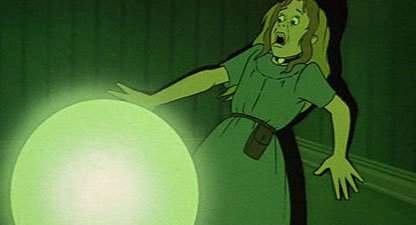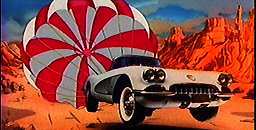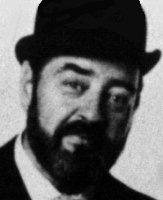Heavy Metal
Distributor: Columbia Pictures
Studio: Guardian Trust Company, Canadian
Film Development Corporation and Famous Players
Individual Segments Created By TV Cartoons, Halas and
Batchelor Cartoon Films, Atkinson Film Arts, Haines-Camron,
Votetone, Boxcar Films and Wally Bulloch-Anicam
Director: Gerald Potterton
Producer: Ivan Reitman
Original Release Date: August 7, 1981
It seems that Heavy Metal is... Well... Problematic... We know that it isn't trying to be anything special, yet the film is bogged down by the poor side of its animation, some of the writing and the overall juvenile tone of the picture. We know that some of the animation is also very good including some then-groundbreaking special effects that either work well ("So Beautiful, So Dangerous") or don't. ("Soft Landing", "Taarna") So we're now down to the last thing about this film, and this is what really works... The soundtrack!
 The film is called Heavy Metal because of the magazine it's based on, but that doesn't mean it can't have a hard rocking soundtrack now can it? If you love classic rock and animation, this is a dream come true. The individual songs are very good, making this one of the best soundtracks for an animated film. Regardless of what scenes the songs play on, they often show up out of nowhere. Elmer Bernstein's score is also good, adding that fantasy element to the picture and it suits the art direction very well.
The film is called Heavy Metal because of the magazine it's based on, but that doesn't mean it can't have a hard rocking soundtrack now can it? If you love classic rock and animation, this is a dream come true. The individual songs are very good, making this one of the best soundtracks for an animated film. Regardless of what scenes the songs play on, they often show up out of nowhere. Elmer Bernstein's score is also good, adding that fantasy element to the picture and it suits the art direction very well.Some tracks actually qualify as heavy metal, while the rest is actually just really good hard rock. The title track, sung by Sammy Hagar, is awesome. It's loud, it's ear-shattering and it just rocks... Don Felder of the Eagles (not Don Henley, mind you) provides two songs, one of which being titled "Heavy Metal (Takin' a Ride)", a great rock song with a chugging riff. This song plays over the first minute of the "B-17" segment, and it suits it perfectly. His other contribution, "All of You", is a slower piece that still works and it's just as good as "Heavy Metal (Takin' a Ride)".
Black Sabbath (with Ronnie James Dio as the lead vocalist) contributes two songs, one of which isn't on the soundtrack itself but in the film only. "E5150" and "The Mob Rules" are used in the "Taarna" segment. "E5150" is a strange instrumental that leads up to "The Mob Rules", and that's the way they're sequenced on Black Sabbath's Mob Rules, which came out the same year. "E5150" is left off of the film's official soundtrack. This baffles me, why did they leave it off the original soundtrack? Perhaps there wasn't enough space on the vinyl? Okay I can understand that, but how come it's not on the CD? Anyways, "The Mob Rules" is another hard rocking song that works well with the scene it's used on. To me, it beats the version on Black Sabbath's Mob Rules album.
We also have a contribution from Journey, a song that already appeared on their 1981 hit album, Escape: "Open Arms". Cheap Trick contributes two energetic rockers, "Reach Out" and "You Must Be Dreamin'". (Which has an incredibly cool intro) Blue Öyster Cult was to offer two songs, but only one made it. "Veteran of the Psychic Wars" is a fine song that's a little lengthy. The other song was unfortunately left off, "Vengeance (The Pact)". The producers turned the song down because they felt that the lyrics summarized the "Taarna" segment in just a matter of minutes. The song appeared on their 1981 album, Fire of Unknown Origins.
Devo had two songs for the film. "Working in the Coal Mine" is used for the end credits, "Through Being Cool" is played by an animatronic band in the bar during the "Taarna" segment. Unfortunately, that great song wasn't on the LP or CD of the soundtrack, just like "E5150". It was instead included on their 1981 album New Traditionalists. Stevie Nicks contributes a lovely song called "Blue Light", which was a Bella Donna outtake, one of many songs that didn't make it to Nicks' debut album.
Nazareth offered "Crazy (A Suitable Case for Treatment)", a solid rocker. Donald Fagen's "True Companion" is a beautiful piece, although it takes a while for the song to get to the vocals. This must've been recorded before or after the recording sessions for Steely Dan's Gaucho. Grand Funk Railroad's "Queen Bee" can also be found on their 1981 album Grand Funk Lives. It's a lot harder than their usual songs, but it's good. Riggs, the band founded by Jerry Riggs (who go on to be co-lead guitarist of the Pat Travers Band), offers two energetic rockers: "Radar Rider" and "Heartbeat". Last but not least is "Prefabricated" by Trust, a French hard rock band. There's also the original French version, as they had to record the song in English for the soundtrack. It's another gem.
What about the score? It's composed by none other than Elmer Bernstein, the perfect choice for this kind of film. You can hear a little Ghostbusters throughout the film, even this came out three years before that film, which coincidentally was directed and produced by Ivan Reitman. Bernstein's score captures the settings of the different segments' atmospheres, and it's definitely one of the film's stronger points. Stand out moments in the score include "B-17", "Den" and "Taarna". It's also notable that Bernstein later composed the score for Disney's The Black Cauldron, which was arguably influenced by this film during production.
So basically, the film has a great soundtrack. The music goes very well with the setting and the tone of the film. While the film does have a lot of flaws, the soundtrack is one of its saving graces. Now that we've covered the story, the soundtrack, the animation and the writing, let's take a look at the production history and what happened after the release of the film.
Work on a feature film based on the magazine began after the success of National Lampoon's Animal House in 1978. Ivan Reitman, the producer of Animal House, became the film's producer. Mogel would also produce the film. The film would feature six stories, two of which were original stories that were true to the spirit of the magazine. They would be linked together with a main plot to make an omnibus anthology film, all set to contemporary hard rock artists and bands. A rock and roll Fantasia if you will, except with a storyline.
The individual stories would be animated by various studios in Canada, the United States and the United Kingdom. Gerald Potterton, who worked on projects such as George Dunning's Yellow Submarine and Richard Williams' Raggedy Ann and Andy: A Musical Adventure, would direct the film. With that, and a $9 million budget, this was shaping up to be an ambitious project. It was also the perfect time to make an adult animated film, as many of those came about after Ralph Bakshi's Fritz the Cat and Heavy Traffic. The Bakshi influence can be seen all over this film.
This was an ambitious idea on its own. While Fantasia's segments were all done at the Walt Disney Studios, Heavy Metal's individual segments would be handled by multiple animation houses in the states, Canada and the UK, thus each one has their own unique style. I may have criticized the work on some of the segments, but at least the segments are visually different from each other. I personally love it when animated films have what TV Tropes calls "art shifts".
During production, there was going to be a segment called "Neverwhere Land" (written by Cornelius Cole), a look into the Loc-Nar and it's influences throughout time. It starts at the beginning of mankind, showing examples of evil all throughout the centuries, and it works its way up to World War II, where it was supposed to segue into "B-17". That would've been a very effective transition, but unfortunately, this segment had to go because of time constraints.
After three years of work, the film was completed and released on August 7, 1981. The film was a success, taking in $20 million at the North American box office while receiving mixed reviews. A couple months later, the soundtrack LP hit stores and reached #12 on the Billboard 200 chart. Elmer Bernstein's score was also released on LP alongside the soundtrack. While the film was a success, it was more of a hit with midnight movie crowd much like The Rocky Horror Picture Show, thus it became a cult classic.
 Unfortunately, there were legal issues over the rights to the music in the film, which resulted in the film being kept from being released on home video. If you wanted to watch Heavy Metal after its initial release, you either had to see a midnight movie screening or it wait for it to show up on HBO. Bootlegs surfaced shortly after. Kevin Eastman, the publisher of the magazine, finally settled all of this in 1995. Heavy Metalreceived a brief theatrical re-release on March 8, 1996 and was then released on home video for the first time in October. (With a subtitle, "Louder and nastier than ever!") The soundtrack was also released on CD for the first time.
Unfortunately, there were legal issues over the rights to the music in the film, which resulted in the film being kept from being released on home video. If you wanted to watch Heavy Metal after its initial release, you either had to see a midnight movie screening or it wait for it to show up on HBO. Bootlegs surfaced shortly after. Kevin Eastman, the publisher of the magazine, finally settled all of this in 1995. Heavy Metalreceived a brief theatrical re-release on March 8, 1996 and was then released on home video for the first time in October. (With a subtitle, "Louder and nastier than ever!") The soundtrack was also released on CD for the first time.3 years later, the film was released on DVD with loads of bonus features, including a workprint of the film that's probably from late 1980 or early 1981. Containing unfinished animation, the deleted "Neverwhere Land" sequence and some scenes that got cut, this workprint is definitely worth watching. Carl Macek provides an informative commentary, which is the way to view the workprint since the only thing you'll hear in the workprint is the dialogue and a couple sound effects. Another version of "Neverwhere Land" appears as its own features on the DVD.
The initial home video release of the film was very successful, as one million units were sold. Production on a sequel began shortly after. The sequel ended up being a direct-to-video release, Heavy Metal 2000, which was poorly received.
Plans to make another Heavy Metal film surfaced around 2008, which was to be directed by David Fincher. This sequel would feature segments directed by James Cameron and Kevin Eastman, and it was revealed that Zack Snyder, Gore Verbinski and Guillermo del Toro wanted to direct some segments. Mark Osborne and Jack Black (Tenacious D) were also set to direct a segment. Sadly, this project was canned. Apparently no distributor was interested in it. Paramount rejected it because they felt it was too risque for mainstream audiences. Are you kidding me?
Robert Rodriguez purchased the rights and announced that he will be developing a Heavy Metalfilm at his new studio, Quick Draw Studios. He launched a website that encouraged fans to submit ideas and contributions. When this film will ever hit theaters is unknown, but it's nice to know that the project is not dead. If it stays true to the spirit of the original with great production values, it should be something worth seeing.
It's no doubt that Heavy Metal was a notable film in animation history. It was certainly influential in some areas, inspiring studios to do films in a similar fashion. Nelvana's Rock and Rule, which was originally going to be a family friendly film called Drats!, was revamped as an adult-oriented rock and roll sci-fi tale. Released in 1983, it was a critical and commercial failure and like Heavy Metal, it became a cult classic. Disney's The Black Cauldron might've borrowed from it as well, being a high fantasy story with dark imagery and a score composed by Elmer Bernstein, not to mention those infamous deleted scenes that were very violent. Something tells me that the Disney animators were definitely influenced by Heavy Metal during production of that film (and the adult animation boom in general), and the studio clearly was aiming for the teen fantasy audience.
Heavy Metal may be a problematic, sophomoric film that hasn't aged well, but why do I find it so fascinating today, 31 years after it first came out? Looking at it as an ambitious, experimental film, I give it credit. I also give it credit for it being an anthology film, something you don't normally see in the world of mainstream animated feature filmmaking. The soundtrack rocks, yes. Is it a good work of storytelling? No. Is the animation good? At times, yes. It's a film that I probably would've considered "the best ever" when I was fourteen years old.
Overall, this film isn't a misfire. It's an enjoyable guilty pleasure with a lot of ambition in it. Definitely worth seeking out, not for the quality, but for something different in the world of feature animation.
Film Grade: C+
Next Up: Another experimental animated film set to the music of one of the world's greatest bands. What is it you might ask? Find on the next episode of "Classic Animation Theater"!


































